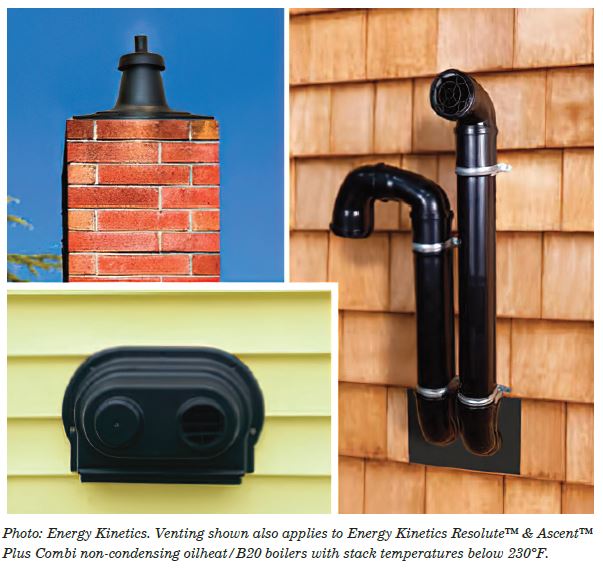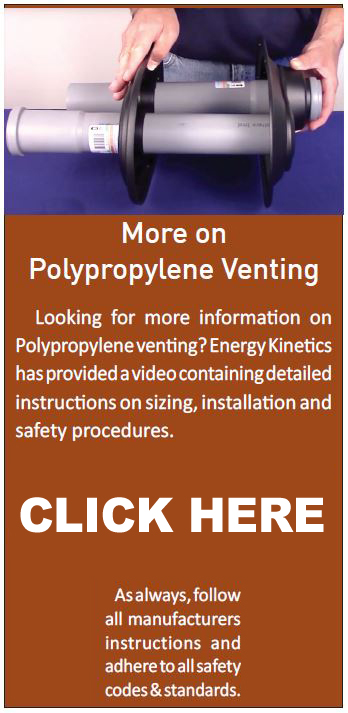Written on: December 12, 2022 by George Carey
Why Polypropylene?
Polypropylene is environmentally-friendly, designed for sustained flue gases up to 230°F (110°C) and provides performance properties better suited to handle flue gases than polyvinyl chloride (PVC) or chlorinated PVC (CPVC) technology.
The polypropylene flue gas vent system is specifically engineered for the intended application. Polypropylene has a vicat softening temperature that exceeds 300°F (meaning the temperature at which the thermal plastic deforms under the load). The polypropylene vent pipe has higher temperature ratings and enhanced corrosion resistance to the acidic properties of the condensate associated with high-efficiency appliances.
Unlike other polymeric or metal systems, polypropylene is resistant to aromatic hydrocarbons, sulfuric acid and hydrochloric acid, which allows it to be used with oil-, propane- and natural gas-fired high-efficiency appliances. It is only limited by the flue gas temperature, making it an ideal choice for condensing heating appliances.
Editors note: Polypropylene venting is also an ideal choice for oilheat non-condensing dilution air boilers, which run with appropriately low vent temperatures and are approved for use with polypropylene venting. Several systems have gained market acceptance in the United States for over a decade, and are also now rated for use with B20 fuel blends.
Polypropylene vent systems are manufactured specifically to perform as a vent system. All the various and necessary components, such as test ports, siphons and condensate drains, are available to install the proper vent system. There is no need to modify the vent system to analyze the combustion numbers or drain excessive condensate from the vent system. The manufacturers offer single-wall pipe, flexible pipe, as well as concentric pipe, so regardless of the structure type, the flue gases from the condensing appliances can be safely vented out of the building to the atmosphere.

The polypropylene venting systems do not use glues and primers to join the lengths of pipes and fittings together. Instead they use a gasketed system to seal each connection point. The gasket technology allows the vent system to be installed rapidly; there is no need to rough-in the fittings as the components can be rotated in place, as well as disassembled. Once the venting system is completed, the high-efficiency appliance can be fired off immediately because, unlike glued systems, there is no 24-hour curing period required.
These polypropylene gas vent systems are designed to be used on condensing heating appliances that can produce one gallon of condensate per hour per hundred thousand British thermal units (BTUs). It is important that the vent system has proper pitch back towards the appliance, while the flue gases flow in the opposite direction towards the vent termination.
The pitch ensures that condensate is not allowed to build up in the vent system, which can cause back pressure leading to a forced shut down of the furnace or boiler. Also, build up of condensate gathering around a gasket can become a leak path, so good pitch allows the condensate to slide past each connection joint all the way back to the condensate trap.
A little history
Polypropylene gas vent systems have been around since 1994 for the European high-efficiency boiler market. The system is listed to the CE EN 14471 Safety Standard; the technology has proven to be safe and reliable. It is the dominating technology in Europe with millions of installations and is utilized by all the European heating equipment manufacturers.
This question comes up from time to time: Is PVC used for venting flue gases in Europe?
The answer is: No, Europe does not use PVC because of its lower maximum operating temperature and environmental health and safety concerns.
Manufacturers of these polypropylene gas vent systems arrived in the U.S. in 2009 and have sold and installed them for the last 13 years. One of the first things they did was obtain the UL-1738 listing to meet the most stringent and applicable safety standard used in the U.S.
Which leads us to the next question…Why UL 1738? The manufacturers of polypropylene gas vent systems had already been listed with Europe’s highest safety standard for venting flue gases from condensing appliances. They realized that, to participate in the U.S. market, they would need to be listed with the highest standard—Underwriters Laboratory-1738 (UL-1738). European manufacturers had an entire polypropylene vent system shipped to the lab to go through exhaustive testing procedures.
The reason why achieving a listing to the UL-1738 standard is so difficult is because there are several additional tests it puts the venting systems through that no other testing standards conduct:
Pressure Testing:
The vent system is tested to 250% of the rated operating pressure.
Leakage Testing:
The highest pressure is used to perform the leak test (3 L/H Max at 100Pa).
Low Temperature Handling:
A drop test is performed at -20°C (-4°F)—requiring no shattering, chips or cracks.
UV Testing:
This involves a 180-day UV Climate Chamber test.
High Temperature Testing:
The vent system is tested 70°F higher than the rated temperature.
Needless to say, the polypropylene gas venting system is a viable option to use when venting the flue gases from a high-efficiency condensing appliance. Because it uses a gasketed technology and not a glued technology, there are some installation details that are very different from what the industry may have been used to over the years. That is why the provision of installation instructions is the most important requirement of gas venting systems manufacturers wanting to be listed with UL-1738. Per the Standard, “Installation instructions shall be illustrated and include directions and information necessary to complete the intended installation of the venting system.” Can you imagine that? ICM
If you have any questions or comments, E-mail me at gcarey@fiainc.com, call 800-423-7187 or follow @Ask_Gcarey on Twitter. ICM 